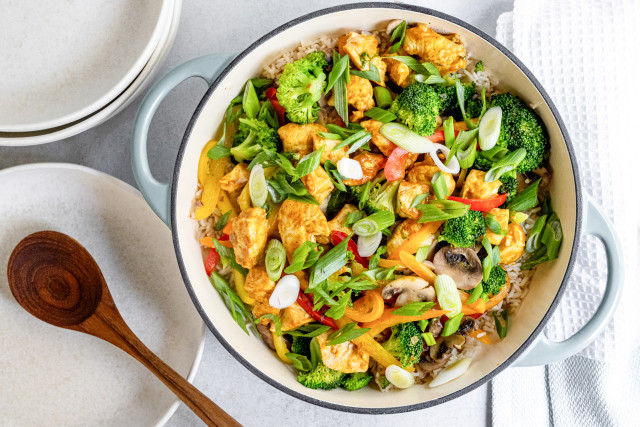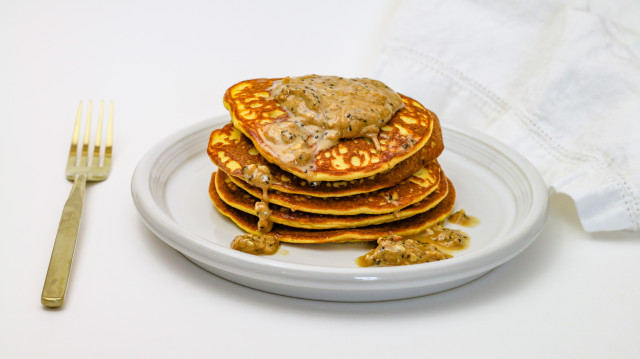
Creamy Fennel Kale Chicken
This dish has all the benefits of a healthy serving of daily greens wrapped up with the subtle flavors of fennel and leeks. Paired with the chicken for protein, this is a flavorful dish that comes together almost as quickly as any convenience food, and is sure to leave you feeling both nourished and satisfied.
Improved Cognitive Health
Kale is a healthy nutrient dense food that is a versatile and tasty addition to any meal. Like many leafy greens, is high in antioxidants, Vitamin K, calcium, and folate. Folate and calcium are important for normal bone health. Folate is one of several essential vitamins that plays an important role in DNA synthesis. It’s presence in your diet encourages healthy cell and tissue growth. Additionally, a recent study published in Neurology, showed that consumption of 1 serving per day of green leafy vegetables was associated with slower cognitive decline.
A Note on Fats
This recipe is baked at 400 F, so choosing the right oil is important. We use avocado oil because, in addition to having a beneficial fatty acid profile, can withstand high temperatures without oxidizing. Avocado oil also has a high smoke point (485F). We are concerned with the former, while culinary professionals are concerned with the latter. The point at which an oil smokes (and thus affects the flavor of the food) and the point at which it oxidizes when exposed to heat, can be very different. Smoke point is a metric that is easy to define. Put simply, it is the point at which an oil, when exposed to heat, begins to produce smoke. Oxidation can occur at much lower temperatures. When a fat is oxidized, it produces free radicals that can be toxic and disruptive to the body.
You may have heard of unsaturated and saturated fats. This classification refers to the number of hydrogen molecules attached to a fatty acid. Saturated fats are fully saturated with hydrogen molecules, whereas, monounsaturated, polyunsaturated and unsaturated fats have several hydrogen molecules “missing”. The more hydrogen molecules the fatty acid lacks, the more unstable it is, and the more susceptible it is to oxidation. Most oils are a mixture of saturated and unsaturated fatty acids, so the fatty acid profile is what we need to decipher in order to determine the suitability of a particular oils for cooking.
In the last 2.5 years Brigid & our team of dietitians have helped 20,000 people incorporate blood sugar balancing meals into their weeks to drastically improve their health. Our blood sugar balancing recipe formula helps really move the needle with your health and all recipes are also easy and delicious. We've compiled hundreds of blood sugar balancing recipes into our meal planning and coaching program, The Being Collective, to help you do the same. By joining The Being Collective, you'll create a weekly plan for you and/or your family (or use one of the pre-made plans created by Brigid & our dietitians) with recipes that are blood sugar balancing, an automated grocery list and a meal prep plan. You can filter based on your personal dietary needs too. The goal is to help you be more consistent but not have to put much thought into it. We'd love for you to join the community!
Creamy Fennel Kale Chicken
2 leeks, thinly sliced
2 bulbs fennel, cored and thinly sliced
1/4 c extra virgin olive oil
1/4 tsp salt
Dash black pepper
5 c kale, chopped
1 lb chicken cutlets
1/2 c chicken broth
1/4 c plain dairy-free yogurt,
1 Tbsp whole grain mustard
Preheat oven to 400 F.
On a baking sheet, place prepared fennel and leeks.
Toss vegetables with 2 tbsp avocado oil, himalayan salt and dash black pepper.
In a separate bowl, massage kale with 1 tbsp avocado oil, dash of salt and pepper and set the kale aside.
Bake fennel and leeks for 40 minutes and add kale to the baking sheet for the last 10-12 minutes of baking.
Heat 1 tbsp olive oil in a large pan, over medium heat.
Add chicken and sauté until lightly cooked, about 3-4 minutes per side.
In a small bowl, mix almond yogurt, chicken broth and mustard and pour on top of chicken.
Add the roasted vegetables to pan and continue to heat for 3 minutes.



